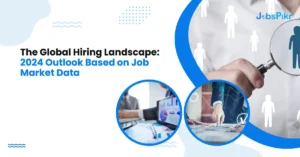If 2020 taught us anything, it is that we should always be prepared for outliers that will eventually become the norm. In a paradigm-shifting year, it is important to analyze how the micro-level disruptions will play out at a macro level economic cycle. The World Economic Forum (WEF) is an international organization that consists of financial gurus across industries who cumulatively work together to analyze and predict what the future of the economy looks like by and large.
The WEF consolidates annual economic and business research documents, including the “The Future of Jobs Report, 2020,” which was recently published. This is usually regarded as The Bible of what is to come. This year, the report talks about how the changes embraced in 2020 by the job market is here to stay for good. These changes are not a stop-gap solution. The future adoption of technology and therefore the future of job boards is highly dependent on the data derived from the study.
It was projected that by 2025, automation and a new synergy of labor between humans and bots will disrupt roughly 85 million jobs globally across 15 industries and 26 economies. But, “COVID-19 has accelerated the arrival of the future of work,” said Saadia Zahidi, Managing Director, World Economic Forum.
Fascinating? Beyond measure. Let us then break down the report and talk about the most interesting takeaways for the future of job markets.
A). New Sense of Urgency for Redefining the Job-Roles Revolution
With the shift brought about by the year that was 2020 and the parallel shift to automation, we are now galloping towards the fourth industrial revolution. Which will create 97 million new roles in industries like artificial intelligence, and in content creation fields. The future doesn’t belong to bots. But in the hands that shape and control them. The tasks where humans will always have a comparative advantage are managing, advising, decision-making, reasoning, communicating and interacting. Parallelly, there will be a surge in demand for candidates who can fill green economy jobs, roles at the cusp of the data, and artificial intelligence economy.
Therefore, nearly 50% of the current workforce will require to reskill or upskill their core skills. To meet the unabated pace of technology, it’s estimated that jobs that are considered redundant will go from more than 15% of a company’s total to less than 10%.
By this data alone, the WEF predicts that nearly 85 million jobs could be displaced for roles that divide human labor from machine labor! While almost 97 million jobs could be created that require skills around machine interaction and algorithmic expertise.

B). Remote Working is The Future of Jobs, with Certain Adaptations
The biggest repercussion of 2020 is remote working. This is the future. Employers say there are the possibility and proclivity to move 44% of the workforce to operate remotely. But this hasn’t come at a real cost. Business leaders expect some unpleasant effects on lower productivity. That means that adopting remote-working technology has become an absolute need of the hour.
On the flip side of remote working comes a looming sense of disconnect between employees and the absence of an opportunity to feed off each other’s energy. To address this primary concern, about one-third of all employers said they will take steps to create a sense of community and belonging within the workforce.

C). Future-Proofing Jobs is The Future of Jobs
Career pivots are to become the “new normal”. The WEF research indicates that a growing number of people are making career switches to entirely unchartered occupations. LinkedIn data gathered over the past five years says that almost 50% of career shifts into data and artificial intelligence are from fields at the opposite end of the spectrum. Karin Kimbrough, Chief Economist at LinkedIn, says that the transition of large populations into jobs of the future has a huge potential for the public and private sector.
If help can be provided to individuals (or companies) who are re-directing workforce funding and investment to identify the skills that would have a disproportionate impact on opening up more ‘secure’ career paths, we can make a real difference in addressing the unprecedented levels of unemployment that we’re seeing globally.
According to WEF data, companies want to re-skill and repurpose nearly half the workers that find themselves displaced by technology instead of hiring a new set. This inclination towards retention and against layoffs represent a sentiment among business leaders that must be capitalized upon.

D). The Future Of ‘Skills’ and The Time it Takes to ‘Reskill’
According to The Future of Jobs Survey, core skills such as critical thinking, analysis, and problem-solving are unsurprisingly at the top of the reskilling and upskilling priorities for business leaders. That’s the age humans need to have over automation. Newly emerging in 2020 are left-brained and emotional intelligence skills such as resilience, stress tolerance, and flexibility.
Data from Coursera implies that employees could start gaining the top 10 skills for each emerging profession in people and culture, content writing, sales, and marketing in less than two months. Those wishing to expand their horizons to product development and artificial intelligence could do so in two to three months, and those switching into cloud computing and engineering could champion the new skillset under five months.
There has been a 5x increase in employers offering employees online learning opportunities, and a nine-fold enrolment increase in candidates accessing online learning through government programs.
Those in employment are more inclined towards soft-skills development courses; those who are unemployed are picking up skills such as data analysis, computer science, information technology, and coding.

Right Table: Top 10 skills for those who are unemployed
The Future of Jobs essentially maps the jobs of the future based on current data reaction to the pace of technology.
It also accounts for the pandemic led shifts and the accelerating effect it has had on the need for automation. Technology is going to be at the core of all tectonic changes in the future. Job automation, primarily. But like we mentioned, the future is not bots and codes. The future is in the hands that code and control.




